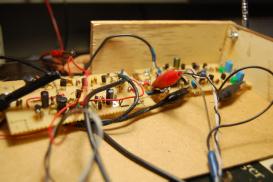This project examines several episodes in the history of researching and utilizing electric and electronic oscillations, connecting narratives from the histories of wireless communication and early electronic musical instruments. At its center is the resonant circuit, a simple circuitry consisting of two electric components, a coil (wrapped wire) and a capacitor (two facing plates). Following the circuit’s biography from the beginning of the nineteenth to the early twentieth century, I analyze moments of its unfolding from unknown matter to a technological condition, which began to change modes of perception from around 1900. The stories the resonant circuit will tell arise at the interface of heterogeneous epistemes relating to physics and acoustics, arts and music, media and technology. Their scenes are a market in Leiden (1748), Hertz’s physical laboratory in Karlsruhe (1860s), the rooftop of the Telharmonic Hall in New York City (1907), a secret Russian laboratory where the engineer Lev Termen works (1919), and the Rundfunkversuchsstelle, an experimental radio lab at the Academy of Music in Berlin (1928). Different discourses tell different stories about these scenes. But how do the stories change when they are told through their electrical components? How is the resonant circuit shaped by different discursive formations and how, in turn, does it reconfigure them? What can circuitry tell us about the contemporaneous emergence of electronic musical instruments and radio technology?

Caption Text: Tinkering with resonant circuitry. Brief function test of a Theremin in the making.
Source: Christina Dörfling.
Project
(2018-2019)
